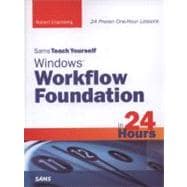
What is included with this book?
Robert Eisenberg, principal, RE Associates, has more than twenty years of application development, consulting training, and management experience. Robert is currently an analyst and consultant specializing in WF, WCF, SharePoint, SOA, BizTalk, and Oslo. Robert’s past experience includes the following: CEO and CTO, U.S. operations of the largest Internet professional services firm in Europe; acting director of enterprise systems at a publicly traded manufacturing company, where he architected and implemented all key business systems; founder and president of a software services company that installed and customized midmarket ERP solutions and created custom systems for Fortune 500 and midsize corporations. Clients included SBC, Ameritech, the Federal Reserve Bank, US West, and Cushman & Wakefield. Robert writes articles and frequently speaks about the topics he consults on at CodeCamp, Integration Journal, and Intelligent Enterprise Magazine.
| Introduction | p. 1 |
| Book Target Audience | p. 2 |
| How This Book Is Organized | p. 2 |
| Hour Summary | p. 3 |
| The Basics | |
| Understanding Windows Workflow Foundation | p. 9 |
| Describing Workflow and Workflow Systems | p. 9 |
| A Conceptual Description of Workflow | p. 9 |
| A Sample Expense Report Workflow | p. 10 |
| Workflow Segmentations | p. 12 |
| What Is a Business Process Management System? | p. 13 |
| NET Framework 3.0 and 3.5 | p. 13 |
| Overview of WF | p. 14 |
| Standard Modeling Activities | p. 16 |
| Multiple Workflow Styles | p. 19 |
| Hosting | p. 23 |
| Tracking | p. 24 |
| Rule Capabilities | p. 26 |
| Conditional Rules | p. 26 |
| RuleSets | p. 27 |
| Custom Activities | p. 29 |
| Reason for Custom Activities | p. 29 |
| Types of Custom Activities | p. 30 |
| XAML Workflows and Serialization | p. 33 |
| Dynamic Update | p. 34 |
| WF and WCF | p. 36 |
| WF and WCF: Conceptual Overview | p. 36 |
| WF and WCF: Integration Specifics | p. 37 |
| SharePoint Workflow | p. 38 |
| SharePoint Workflow Overview | p. 38 |
| SharePoint Workflow Visual Studio | p. 40 |
| SharePoint Workflow SharePoint Designer | p. 40 |
| Designer Rehosting and External Modeling | p. 41 |
| Summary | p. 43 |
| Installation Instructions | p. 44 |
| Visual Studio 2005 and .NET Framework 3.0 Installation Directions | p. 44 |
| Visual Studio 2008 and .NET Framework 3.5 Installation Requirements/Directions | p. 45 |
| A Spin Around Windows Workflow Foundation | p. 47 |
| Creating a Basic Workflow | p. 47 |
| Creating a Workflow Project | p. 47 |
| Building and Running a Workflow | p. 49 |
| Enhancing the Workflow | p. 53 |
| Improving Workflow Transparency | p. 57 |
| Passing Parameters to the Workflow | p. 58 |
| Using Declarative Rules | p. 60 |
| Adding New Activities | p. 60 |
| Creating the Declarative Rule | p. 61 |
| Examining the Project Files | p. 63 |
| Creating a XAML + Code W | |
| Table of Contents provided by Publisher. All Rights Reserved. |
The New copy of this book will include any supplemental materials advertised. Please check the title of the book to determine if it should include any access cards, study guides, lab manuals, CDs, etc.
The Used, Rental and eBook copies of this book are not guaranteed to include any supplemental materials. Typically, only the book itself is included. This is true even if the title states it includes any access cards, study guides, lab manuals, CDs, etc.